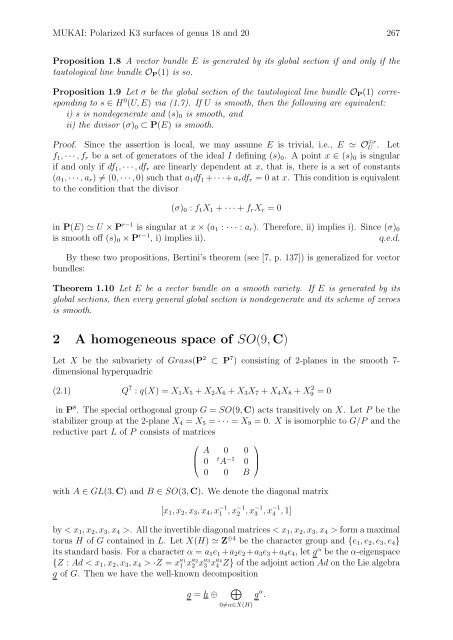Polarized K3 surfaces of genus 18 and 20 - Research Institute for ...
Polarized K3 surfaces of genus 18 and 20 - Research Institute for ...
Polarized K3 surfaces of genus 18 and 20 - Research Institute for ...
You also want an ePaper? Increase the reach of your titles
YUMPU automatically turns print PDFs into web optimized ePapers that Google loves.
MUKAI: <strong>Polarized</strong> <strong>K3</strong> <strong>surfaces</strong> <strong>of</strong> <strong>genus</strong> <strong>18</strong> <strong>and</strong> <strong>20</strong> 267<br />
Proposition 1.8 A vector bundle E is generated by its global section if <strong>and</strong> only if the<br />
tautological line bundle O P (1) is so.<br />
Proposition 1.9 Let σ be the global section <strong>of</strong> the tautological line bundle O P (1) corresponding<br />
to s ∈ H 0 (U, E) via (1.7). If U is smooth, then the following are equivalent:<br />
i) s is nondegenerate <strong>and</strong> (s) 0 is smooth, <strong>and</strong><br />
ii) the divisor (σ) 0 ⊂ P(E) is smooth.<br />
Pro<strong>of</strong>. Since the assertion is local, we may assume E is trivial, i.e., E ≃ OU ⊕r . Let<br />
f 1 , · · · , f r be a set <strong>of</strong> generators <strong>of</strong> the ideal I defining (s) 0 . A point x ∈ (s) 0 is singular<br />
if <strong>and</strong> only if df 1 , · · · , df r are linearly dependent at x, that is, there is a set <strong>of</strong> constants<br />
(a 1 , · · · , a r ) ≠ (0, · · · , 0) such that a 1 df 1 + · · · + a r df r = 0 at x. This condition is equivalent<br />
to the condition that the divisor<br />
(σ) 0 : f 1 X 1 + · · · + f r X r = 0<br />
in P(E) ≃ U × P r−1 is singular at x × (a 1 : · · · : a r ). There<strong>for</strong>e, ii) implies i). Since (σ) 0<br />
is smooth <strong>of</strong>f (s) 0 × P r−1 , i) implies ii).<br />
q.e.d.<br />
By these two propositions, Bertini’s theorem (see [7, p. 137]) is generalized <strong>for</strong> vector<br />
bundles:<br />
Theorem 1.10 Let E be a vector bundle on a smooth variety. If E is generated by its<br />
global sections, then every general global section is nondegenerate <strong>and</strong> its scheme <strong>of</strong> zeroes<br />
is smooth.<br />
2 A homogeneous space <strong>of</strong> SO(9, C)<br />
Let X be the subvariety <strong>of</strong> Grass(P 2 ⊂ P 7 ) consisting <strong>of</strong> 2-planes in the smooth 7-<br />
dimensional hyperquadric<br />
(2.1)<br />
Q 7 : q(X) = X 1 X 5 + X 2 X 6 + X 3 X 7 + X 4 X 8 + X 2 9 = 0<br />
in P 8 . The special orthogonal group G = SO(9, C) acts transitively on X. Let P be the<br />
stabilizer group at the 2-plane X 4 = X 5 = · · · = X 9 = 0. X is isomorphic to G/P <strong>and</strong> the<br />
reductive part L <strong>of</strong> P consists <strong>of</strong> matrices<br />
⎛<br />
⎜<br />
⎝<br />
A 0 0<br />
0 t A −1 0<br />
0 0 B<br />
with A ∈ GL(3, C) <strong>and</strong> B ∈ SO(3, C). We denote the diagonal matrix<br />
⎞<br />
⎟<br />
⎠<br />
[x 1 , x 2 , x 3 , x 4 , x −1<br />
1 , x −1<br />
2 , x −1<br />
3 , x −1<br />
4 , 1]<br />
by < x 1 , x 2 , x 3 , x 4 >. All the invertible diagonal matrices < x 1 , x 2 , x 3 , x 4 > <strong>for</strong>m a maximal<br />
torus H <strong>of</strong> G contained in L. Let X(H) ≃ Z ⊕4 be the character group <strong>and</strong> {e 1 , e 2 , e 3 , e 4 }<br />
its st<strong>and</strong>ard basis. For a character α = a 1 e 1 +a 2 e 2 +a 3 e 3 +a 4 e 4 , let g α be the α-eigenspace<br />
{Z : Ad < x 1 , x 2 , x 3 , x 4 > ·Z = x a 1<br />
1 x a 2<br />
2 x a 3<br />
3 x a 4<br />
4 Z} <strong>of</strong> the adjoint action Ad on the Lie algebra<br />
g <strong>of</strong> G. Then we have the well-known decomposition<br />
g = h ⊕<br />
⊕<br />
0≠α∈X(H)<br />
g α .
















